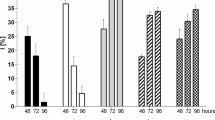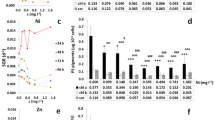Abstract
The unicellular red alga Cyanidium caldarium is tolerant to high levels of various metal ions. Cells of this alga cultured with divalent metal ions at 5 mM contained an elevated concentration of each metal, with the highest level for Zn followed by Mn > Ni > Cu. This order is in fair agreement with the toxicity levels reported previously, with the exception of Mn, which shows a toxicity level comparable to that of Ni. Transmission electron microscopy indicated the presence of electron-dense bodies in the algal cells, and elemental analysis by energy dispersive X-ray spectrometry showed high levels of Fe and P in these bodies. Accumulation of Zn was found in these particles in Zn-treated algal cells, whereas no such deposition was found for Cu, Ni, or Mn in cells treated with the respective metals. Although trapping of Zn in the intracellular bodies may contribute to reduction of metal activity in the cells, this effect can be overcome by high intracellular levels of Zn that result in a high degree of toxicity. The correlation between intracellular concentration and toxic levels of metal ions implies that the reduced incorporation of the metals is a major detoxification mechanism in this alga.
Similar content being viewed by others
References
Ahlf W. 1988 Recovery of metals from acid waste water by Cyanidium caldarium. Appl Microbiol Biotechnol 28, 512-513.
Allen MB. 1959 Studies with Cyanidium caldarium, an anomalously pigmented chlorophyte. Archiv Mikrobiol 32, 270-277.
Chapman DJ. 1974 Taxonomic status of Cyanidium caldarium. The porphyridiales and goniotrichales. Nova Hedwigia 25, 673-682.
Dean JA. 1999 Lange's Handbook of Chemistry. 15thed. Electrolytes, Electromotive Force and Chemical Equilibrium. New York: McGraw-Hill; 8.6-8.17
Geitler L. 1933 Diagnosen neuer Blaualgen von den Sunda-Inseln. Arch Hydrobiol Suppl 12, 622-634.
Goldberg J, Gonzalez H, Jensen TE, Corpe WA. 2001 Quantitative analysis of the elemental composition and the mass of bacterial polyphosphate bodies using STEM EDX. Microbios 106, 177-188.
Kuroiwa T, Kawazu T, Takahashi H, Suzuki K, Ohta N, Kuroiwa H. 1994 Comparison of ultrastructures between the ultra-small eukaryote Cyanidioschyzon merolae and Cyanidium caldarium. Cytologia 59, 149-158.
Nagashima H, Fukuda I. 1981 Morphological properties of Cyanidium caldarium and related algae in Japan. Jap J Phycol (SÔrui) 29, 237-242.
Nagasaka S, Nishizawa NK, Negishi T, Satake K, Mori S, Yoshimura E. 2002 Novel iron storage particles may play a role in aluminum tolerance of Cyanidium caldarium. Planta 215, 399-404.
Nagasaka S, Nishizawa NK, Watanabe T, Mori S, Yoshimura E. 2003 Evidence that electron-dense bodies in Cyanidium caldarium have an iron-storage role. Biometals, 16, 465-470.
SchÖnborn C, Bauer HD, RÖske I. 2001 Stability of enhanced biological phosphorus removal and composition of polyphosphate granules. Water Res 35, 3190-3196.
Sakurai H, Nishida M. 1982 EPR detection and characterization of manganous(II) ion in subcellular fractions of the liver and kidney and thyroid homogenate of mice treated with manganese chloride. Inorganica Chimica Acta 66, L17-L20.
Wood JM, Wang H-K. 1983 Microbial resistance to heavy metals. Environ Sci Technol 17, 582-590.
Yoshimura E, Nagasaka S, Sato Y, Satake K, Mori S. 1999 Extraordinarily high aluminium tolerance of the acidophilic thermophilic alga, Cyanidium caldarium. Soil Sci Plant Nutr 45, 721-724.
Yoshimura E, Nagasaka S, Satake K, Mori S. 2000 Mechanism of aluminium tolerance in Cyanidium caldarium. Hydrobiol 433, 57-60.
Author information
Authors and Affiliations
Corresponding author
Rights and permissions
About this article
Cite this article
Nagasaka, S., Nishizawa, N.K., Mori, S. et al. Metal metabolism in the red alga Cyanidium caldarium and its relationship to metal tolerance. Biometals 17, 177–181 (2004). https://doi.org/10.1023/B:BIOM.0000018403.37716.ff
Issue Date:
DOI: https://doi.org/10.1023/B:BIOM.0000018403.37716.ff




